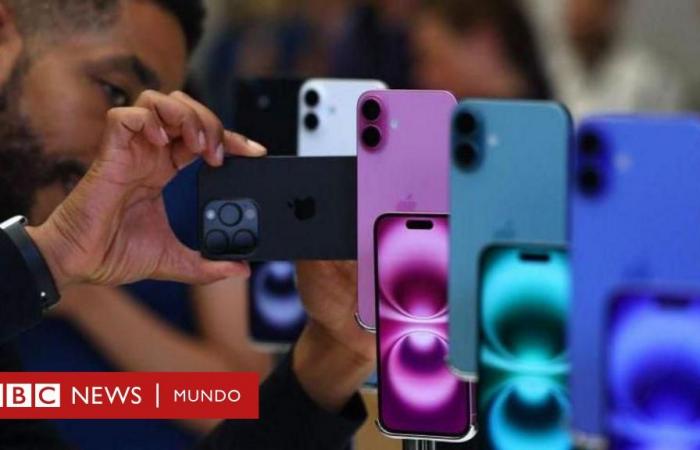Image source, Getty Images
- Author, Writing
- Author’s title, BBC News world
-
50 minutes
The most popular devices in the world –Thephones, laptops, tablets and smart watches were exposed to considerable price increase in the United States.
Many of these are manufactured in China, and President Donald Trump imposed a 145% tariff on the products imported from the Asian giant, although he then temporarily exempted from that electronic tax.
The future effect that this could have on the iPhone and its manufacturer, Apple, is a question.
Some analysts claimed weeks ago that if import costs were transferred to consumers, iPhone prices in the US could increase hundreds of dollars.
And if tariffs have an effect on the value of the dollar, it could be more expensive to import iPhones and other devices worldwide.
There could also be a significant change if the cost of tariffs moves to global consumers: users could have to sign longer contracts with telephone operators to distribute the value of the device over time.
While a telephone contract in many countries usually lasts two years, some companies already offer four -year contracts, said Ben Wood, of the British market researcher CCS Insight, who believes that “we could see five -year contracts” in 2025.
“You could say that it is almost like having a mortgage for your smartphone,” he said.
Where are iPhone manufactured?
USA is an important market for the iPhone and Apple sold more than half of the total smartphones Marketed last year in that country, according to the consulting firm of the Counterpoint Research technological market.
The firm indicates that up to 80% of Apple iPhones for sale in the US are manufactured in China, and the remaining 20% in India.
Image source, Getty Images
Together with other mobile telephony giants such as the Korean Samsung, Apple has been trying to diversify in recent years its supply chains to avoid excessive dependence on China.
This is how India and Vietnam positioned themselves as candidates for the establishment of new manufacturing centers.
Samsung, for example, manufactures more than 60% of its telephones in Vietnam, according to Counterpoint Research.
Is it possible to manufacture iPhones in the US?
Trump and his advisors have affirmed that the objective of their tariffs is to promote greater production in the US.
when on April 12 the president paused these rates in the case of electronic products, he instructed the trade department to make a market investigation into semiconductors and gave him up to 270 days to make his recommendations, although those conclusions and the subsequent decision of Trump could arrive before.
Stephen Miller, a White House policy cabinet submEfe, warned of X that these electronic products are still subject to the 20% tariff imposed on China for fentanyl.
The White House indicated that the exemptions were implemented to ensure that companies had more time to move production to the US.
“President Trump has made it clear that the US cannot depend on China for the manufacture of critical technologies such as semiconductors, chips, smartphones and laptops,” said White House press secretary, Karoline Leavitt, in a statement.
“Following the president’s instructions, these companies are rushing to transfer their production to the US as soon as possible,” he added.
Image source, Reuters
The technology industry depends on a global suppliers network for the components and assembly of its products.
This, added to the need to find qualified workers who fit the rapid rhythm and low production cost in Asia, implies that relocating supply chains is not an easy task.
Apple committed an investment of US $ 500,000 million in the US in February, which, according to Trump’s government, will result in a higher local production.
However, the analyst Dan Iives, from Wedbush Securities, said that moving parts of his supply chain from cheaper manufacturing centers in Asia to the US would require a lot of time and money.
“The reality is that, according to our estimates, three years and US $ 30,000 million would be needed to transfer even 10% of its Asia supply chain to the US, with an important interruption in the process,” he wrote on X on April 3.
Will the price of the iPhone upload?
Apple has not yet revealed whether a change in its price strategy plans.
Some estimates suggest that iPhone prices in the US could even triple if the costs moved to consumers.
Before Trump increased the tariff to China to 145%, when the rise had reached 125%, the UBS investment bank estimated that the price of an iPhone 16 Pro Max manufactured in that Asian country with 256 GB of storage would shoot at US $ 1,199 to US $ 1,999 plus taxes (which depend on the state and the county, but vary between 0% and almost 13%).
Image source, Getty Images
These experts calculated a less significant increase for the iPhone 16 Pro of 128 GB of storage, manufactured in India, 5%, from US $ 999 to US $ 1,046 plus taxes.
Meanwhile, some analysts such as Dan IVES have suggested that the price of an iPhone “made in the US” It could shoot at US $ 3,500.
Apple’s drastic decision
To counteract the negative effects of Trump’s foreign trade policy, Apple announced Thursday that it will move the production of most iPhones and other devices that it sells in the US and will no longer be manufactured in China.
“For the quarter that ends in June, we foresee that most of the iPhones sold in the US come from India, and that Vietnam is the country of origin of almost all iPad, Mac, Apple Watch and Airpods sold in the US,” said the company’s executive director Tim Cook.
This occurs while the technological giant estimates that taxes on US imports could add around 900 million dollars to its costs in the current quarter, despite Trump’s decision to exempt the key electronic products of the new tariffs.
However, transferring the production lines to India will require time and an investment of billions of dollars.
“There will continue to exist tariffs that affect supply chains [de Apple] And a cost to transfer them and build new factories, “said Shanti Kelemen, M&G Wealth investments director, to the BBC.
Image source, Getty Images
Apple’s drastic decision was “impressive,” according to Patrick Moorhead, executive director of Moor Insights & Strategy.
“This is a remarkable change with respect to what [Cook] He said a few years ago, when he said that only China could manufacture iPhones, “Moorhead said.
“Apple must show great progress in this aspect, but it is a good start,” he concluded.
What will happen in Latin America?
In Latin America, economic reality causes most consumers to opt for cheaper phones than Apple’s, a brand that focuses on the market prémona segment.
The company has 8% of the market and is widely exceeded by competitors such as Samsung, Xiaomi and Motorola, according to the Market consultant Canals.
In addition, there is a wide variety of prices in the region, depending on each country.
Buying an iPhone 16 Pro Max costs more than US $ 2,900 in Argentina, while in Costa Rica it can be purchased for just over US $ 1,300.
So, the iPhones that arrive in Latin America will be of Indian origin from now? The Vietnam iPads? Will tariffs affect the prices paid in the region?
Los smartphones Apple arriving in Latin America will continue to be manufactured in China, according to the company.
“China will continue to be the country of origin of the vast majority of total sales of products outside the US,” said Tim Cook on Thursday.
That will not have an impact on the price, because Apple devices sold in Latin America do not pass before by the US, and therefore the extraction of Trump tariffs are not imposed.
We will probably have to wait until September to see how much the next model will cost.
The iPhone is still one of the smartphones More expensive on the market, and brands like Google and Samsung offer in the US phones with similar features at a lower price.
In Latin America, Xiaomi, Itel, Tecno, Infinix or Motorola also have devices at lower prices.
The other option, and perhaps the most profitable, could be that users avoid updating to newer iPhone models and opt for slightly older and more economical versions.
Subscribe here To our new newsletter to receive every Friday a selection of our best content of the week.
And remember that you can receive notifications in our app. Download the latest version and act.






